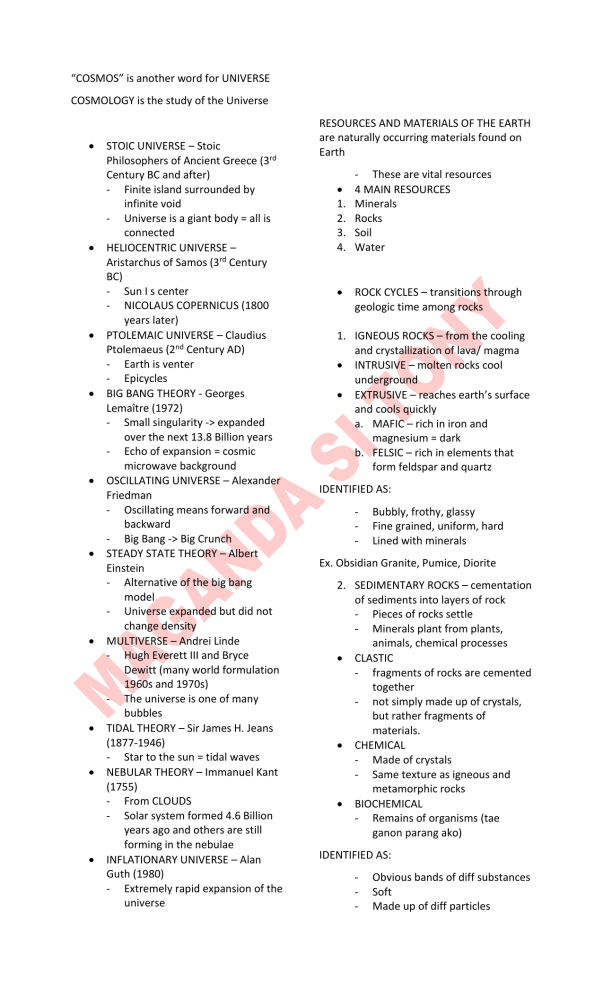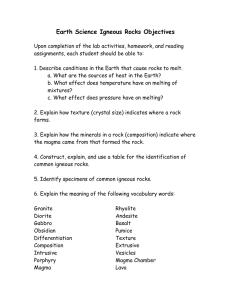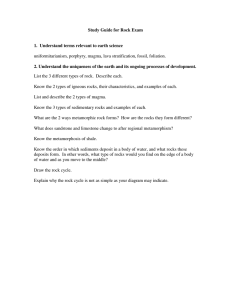earthlife reviwer
advertisement

“COSMOS” is another word for UNIVERSE COSMOLOGY is the study of the Universe STOIC UNIVERSE – Stoic Philosophers of Ancient Greece (3rd Century BC and after) - Finite island surrounded by infinite void - Universe is a giant body = all is connected HELIOCENTRIC UNIVERSE – Aristarchus of Samos (3rd Century BC) - Sun I s center - NICOLAUS COPERNICUS (1800 years later) PTOLEMAIC UNIVERSE – Claudius Ptolemaeus (2nd Century AD) - Earth is venter - Epicycles BIG BANG THEORY - Georges Lemaître (1972) - Small singularity -> expanded over the next 13.8 Billion years - Echo of expansion = cosmic microwave background OSCILLATING UNIVERSE – Alexander Friedman - Oscillating means forward and backward - Big Bang -> Big Crunch STEADY STATE THEORY – Albert Einstein - Alternative of the big bang model - Universe expanded but did not change density MULTIVERSE – Andrei Linde - Hugh Everett III and Bryce Dewitt (many world formulation 1960s and 1970s) - The universe is one of many bubbles TIDAL THEORY – Sir James H. Jeans (1877-1946) - Star to the sun = tidal waves NEBULAR THEORY – Immanuel Kant (1755) - From CLOUDS - Solar system formed 4.6 Billion years ago and others are still forming in the nebulae INFLATIONARY UNIVERSE – Alan Guth (1980) - Extremely rapid expansion of the universe RESOURCES AND MATERIALS OF THE EARTH are naturally occurring materials found on Earth 1. 2. 3. 4. - These are vital resources 4 MAIN RESOURCES Minerals Rocks Soil Water ROCK CYCLES – transitions through geologic time among rocks 1. IGNEOUS ROCKS – from the cooling and crystallization of lava/ magma INTRUSIVE – molten rocks cool underground EXTRUSIVE – reaches earth’s surface and cools quickly a. MAFIC – rich in iron and magnesium = dark b. FELSIC – rich in elements that form feldspar and quartz IDENTIFIED AS: - Bubbly, frothy, glassy Fine grained, uniform, hard Lined with minerals Ex. Obsidian Granite, Pumice, Diorite 2. SEDIMENTARY ROCKS – cementation of sediments into layers of rock - Pieces of rocks settle - Minerals plant from plants, animals, chemical processes CLASTIC - fragments of rocks are cemented together - not simply made up of crystals, but rather fragments of materials. CHEMICAL - Made of crystals - Same texture as igneous and metamorphic rocks BIOCHEMICAL - Remains of organisms (tae ganon parang ako) IDENTIFIED AS: - Obvious bands of diff substances Soft Made up of diff particles - Contains fossils 3. METAMORPHIC – formed by heat and pressure FOLIATED – layered appearance NON-FOLIATED – no layered/banded appearance MINERAL 3. - Naturally formed Solid w/ definite chemical composition - characteristic crystalline appearance SILICATE - Silicon and oxygen - Make up 90% of Earth’s crust NON-SILICATE - Carbonates, Sulfates, Oxides, Sulfides, Phosphates, Halides, Native Elements 2. PHYSICAL CHARACTERISTICS OF ROCKS 1. COLOR – caused by wavelengths of light 2. STEAK – color displayed by a mineral when turned to fine powder 3. DENSITY – mass per unit volume (d=m/v) 4. LUSTER – opacity and transparency 5. HARDNESS – level of difficulty to be scratched 6. CLEAVAGE – split along smooth plane (sana all meron) 7. FRACTURE – doesn’t form perfect/distinct cleavage 8. TENACITY – behavior under stress/deformation 4. 5. 6. (for nitrogen, carbon, oxygen dynamics) EARTH’S DOSTANCE FROM THE SUN HABITABLE ZONE – range of orbits around a star which can support water SOURCE OF HEAT GREENHOUSE EFFECT - Warm Earth’s surface and lower atmosphere - Half of solar radiation ROLE OF ATMOSPHERE Helps maintain consistent temp Shields earth from collisions Oxygen level is at 21% ACTIVE PLATE TECTONICS AND DIFFERENTIATED INTERNAL STRUCTURE PRESENCE OF THE MOON AND TILT OF AXIS - Earth’s motion = rotation and revolution Axis – imaginary line which a body rotates - EARTH’S SYSTEMS 1. LITHOSPHERE – solid earth 2. BIOSPHERE – living organisms 3. HYDROSPHERE – 71% ocean 12,500 ft deep 4. ATMOSPHERE – thin layer of gas (meron pa teka lang madami pa to) ESTRATERRESTRIAL IMPACT - (onting kembot pa wait lang) WHAT MAKES EARTH HABITABLE? 1. Life would not begin without water - For photosynthetic organisms CYANOBACTERIA – prokaryotes that Tilted 23.5 degrees Causes primordial heat through kinetic energy GRAVITAIONAL CONTRACTION OF EARTH’S INTERIOR - Accretionary process forces earth to contract = conversion of gravitational energy to heat energy RADIOACTIVE DECAY OF UNSTABLE ISOTOPES - Produces subatomic particles that collide and cause heat MAGMATISM – formation and movement of magma under crust capture sunlight using chlorophyll Key role in mountain formation Magma – molten rocks beneath earth’s surface - 45% to 75% silica - 800 to 1400 C melting point CONDITIONS REQUIRED IN THE GENERATION OF MAGMA FORMATION Decompression Melting – temp stays but pressure decreases Flux Melting – volatiles are added to hot liquid rocks Heat Transfer Melting – melting of surrounding rocks AREAS WHERE MAGMA IS GENERATED: 1. Oceanic Ridge - Submarine volcano - Basaltic magma 2. Islandic Arc - Japan Archipelago - Subduction of Oceanic plate at a trench - Andesite magma, dacite magma 3. Hot spot - Hawaii island, Iceland - Mantle gushes up through tubes No change in chemical composition Exfoliation – buried rocks are uplifted and exposed Frost Wedging Salt Wedging CHEMICAL WEATHERING – through chemical changes in its minerals PROCESS: 1. Oxidation – reddish coloration like rust 2. Hydrolysis – igneous rocks have much silica which readily combines with water 3. Carbonation and Solution – carbon dioxide + water = soluble product BIOLOGICAL WEATHERING – plants and animal Roots physically break rock Lichens remove weaken rocks Burrowing animals increase weathering ( wait ders more parekoy) VOLCANISM - Through HUMAN perspective is DESTRUCTIVE Through GEOLOGIC perspective is a CONSTRUCTIVE process GEOMORPHIC PROCESSES A. 1. 2. B. - Create and modify landforms ENDOGENOUS PROCESSES - Large scale landform building and transforming - Create relief Igneous Process a. Volcanism – volcanic eruption b. Plutonism – igneous intrusion Tectonic Processes a. Folding – mountains b. Faulting – rift valleys, graben, escarpments c. Lateral Faulting – strike slip faults EXOGENOUS PROCESSES - Modify relief a. Degradation Weathering – disintegration and decomposition of rocks in situations with no transportation = regolith PHYSICAL/MECHANICAL WEATHERINGweather elements, extreme temps EROSION AND TRANSPORTATION - Various geomorphic agents Erosional feature: 1. Flowing water – fluvial morphology 2. Wind – Eolian Landscapes 3. Tides and Waves – Coastal Morphology 4. Moving Ice – Glacial Morphology DEPOSITION Various geomorphic agents associated and resulting Depositional features Fluvial – humid regions Eolian – Sand dunes Coastal – Sea beaches and coral reefs Glacial – alpine EOLIAN- sediment erosion, transportation, and deposition by wind. ALLUVIAL FAN - cover of soil, sand, and fine grained rocks on the Earth’s surface. GLACIER - carry lots of loose rock and debris. Glacial sediment is deposited as the ice melts. FLUVIAL - river environments. DELTA - sediment deposit that forms at the mouth or a river, where it enters a lake or the ocean. DEFORMATION – a process in which rocks change size, shape, location due to squeezing, stretching, or shearing TYPES OF STRESS ( ETO STRESS TO SOBRA ) Stress is a force applied per unit area 1. UNIFORM STRESS – from all directions - Confining stress 2. DIFFERENTIAL STRESS – not equal from all direction - Tensional (Away from each other) - Compressional (towards each other) - Shear (towards each other but not same axis) *shear diba yun yung sabi mo sa kaklase mong may baon? “pre pashear naman aq hihi”* STRAIN – resulting change in rocks due to different kinds of stress 2 KINDS OF STRAIN 1. Shear – involves movement in one part 2. Elastic – temporary SUCCESSIVE STAGES OF DEFORMATION 1. Elastic – reversible strain 2. Ductile – irreversible 3. Fracture – permanent STRUCTURAL GEOLOGY – study of rock deformation STRIKE – compass direction, intersection of inclined plane and horizontal plane DIP – angle between inclined plane and horizontal plane FAULT – planar structures resulting from brittle deformation Active faults – Sliding in recent geologic times HANGING WALL – block of rock on top of the fault FOOTWALL- rock below fault TYPES OF FAULTS 1. Dip-slip – shifted vertically 2. Strike-slip – slide past each other 3. Normal Fault – hanging wall moves down 4. Reverse Fault – hanging wall moves up 5. Thrust Fault – reverse fault with inclination of 35 degrees 6. Right-lateral – towards the right 7. Left-lateral – moves to the left 8. Oblique – diagonal FOLDS – deformation of ductile materials PARTS OF A FOLD: Hinge line/Fold Axis – curvature is greatest Limbs – sides of the folds Axial plane – contains fold axis of folded layers TYPES OF FOLD: 1. Anticline – limbs are inclined away from hinge 2. Syncline – limbs incline toward the hinge 3. Monocline – bend in a flat rock layer 4. Overturned – axial plane is inclined and one limb is higher TECTONIC FOLIATION – alignment of deformed grains MOUNTAIN BUILDING Uplift – lower elevation to higher elevation Orogenesis – mountain building Crustal root – thickened crust Isostasy – adjustment to maintain buoyancy HORSTS – elevated landforms, bounded by faults inclined to opposite directions GRABENS – valleys filled with sediments, bounded by normal faults inclined towards each other ORGANIC BELT/MOUNTAIN BELT – development where new rocks are produced EVIDENCES: 1. FOSSIL EVIDENCE 2. GLACIAL DEPOSITS 3. TECTONIC FIT 4. JIGSAW FIT 5. GEOLOGICAL FIT METAMORPHISM – rocks change without melting or disintegration Protolith – original rock PROCESSES INVLOVED IN METAMORPHISM Recrystallization – change shape and size w/o changing identity Phase Change – new minerals with different crystal structure Neocrystallization – new minerals that differ from those in the protolith. Pressure solutions – squeezed in one direction, low temp and pressure with water Plastic Deformation – flattened but no change in composition or crystal structure CAUSE OF METAMORPHISM 1. 2. 3. 4. Heat Pressure Different Stress Hydrothermal Fluids Metasomatism – hydrothermal fluids are involved in the change of chemical composition TYPES OF METAMORPHISM: 1. Contact Metamorphism – due to heat 2. Burial Metamorphism – buried = diagenesis 3. Dynamic/Cataclastic Metamorphism – shearing = mylonite 4. Regional Metamorphism – change in pressure and temp over large region of crust 5. Hydrothermal Metamorphism – high temp fluid 6. Shock Metamorphism – heat and pressure deform underlying rock layers CONTINENTAL DRIFT THEORY – all continents were once a single land called PANGAEA - ALFRED WEGENER CRUST CONTINENTAL CRUST – 10-7km Oceanic crust – 7km / young PLATE TECTONICS – deformation of crust as a consequence of plate interaction ASTHENOSPHERE is just below the LITHOSPHERE (crust and upper part of the mantle) PLATES – moved around by hot mantle convection cells DIVERGENT - <> Spreading ridges – new material erupts to fill gap CONVERGENT - >< - Continent to continent Continent to oceanic (subduction) Oceanic to oceanic (subduction zone) TRANSFORM - //




